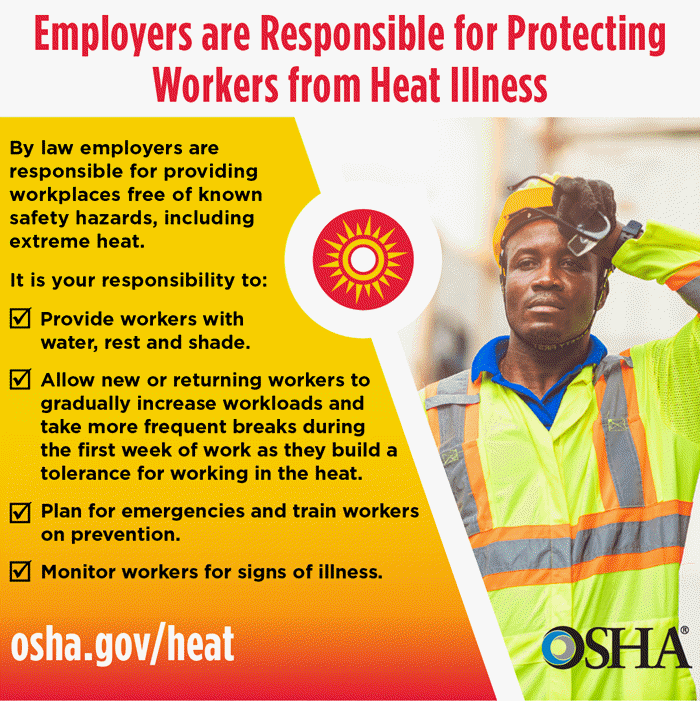Triple heat temperatures are hitting many areas of California this weekend, with some of the highest temperatures affecting the Central Valley.
This is the first major heat wave of the season, which poses a great risk for outside workers who are not acclimatized to working in the heat outdoors.
Steps to Prevent Heat Illness
When working in these hotter conditions for the first time this year, workers must be closely observed for any signs of heat illness.
Employers with outdoor workers in all industries must take the following steps to prevent heat illness:
- Plan – Develop and implement an effective written heat illness prevention plan that includes emergency response procedures.
- Training – Train all employees and supervisors on heat illness prevention.
- Water – Provide drinking water that is fresh, pure, suitably cool and free of charge so that each worker can drink at least 1 quart per hour, and encourage workers to do so.
- Rest – Encourage workers to take a cool-down rest in the shade for at least five minutes when they feel the need to do so to protect themselves from overheating. Workers should not wait until they feel sick to cool down.
- Shade – Provide proper shade when temperatures exceed 80 degrees. Workers have the right to request and be provided shade to cool off at any time.
 Workers who have existing health problems or medical conditions that reduce tolerance to heat, such as diabetes, need to be extra vigilant. Some high blood pressure and anti-inflammatory medications also can increase a worker’s risk for heat illness.
Workers who have existing health problems or medical conditions that reduce tolerance to heat, such as diabetes, need to be extra vigilant. Some high blood pressure and anti-inflammatory medications also can increase a worker’s risk for heat illness.
To prevent heat illness, it is crucial that supervisors are effectively trained on emergency procedures in case a worker gets sick. This helps ensure sick employees receive treatment immediately and that the symptoms do not develop into a serious illness or death.
In certain industries, when the temperature at outdoor worksites reaches or exceeds 95 degrees, Cal/OSHA’s standard requires additional protections. The industries with additional high-heat requirements are agriculture, construction, landscaping, oil and gas extraction and transportation of agricultural products, construction materials or other heavy materials. High-heat procedures include ensuring employees are observed regularly for signs of heat illness and establishing effective communication methods so workers can contact a supervisor when needed.
Resources Available
For more information on what signs of heat illness looks like, visit the “What Is Heat Illness” Cal/OSHA web page here.
For a free printable “pocket guide” for workers—a pdf that lists the signs of heat illness in English and Spanish created by Cal/OSHA, click here.
Materials
Cal/OSHA’s Heat Illness Prevention special emphasis program includes enforcement of heat regulations, as well as multilingual outreach and training programs for California’s employers and workers.
Details on heat illness prevention requirements and training materials are available online at Cal/OSHA Heat Illness Prevention webpage and the 99calor.org informational website. A Heat Illness Prevention online tool also is available.
Cal/OSHA Consultation Services
Employers who have questions or need assistance with workplace health and safety programs can call Cal/OSHA’s Consultation Services Branch at (800) 963-9424.
Outdoor Heat Illness Prevention Plan
California Chamber of Commerce members can use the Heat Illness Prevention Plan – Outdoor Employees to develop a company plan and procedures for complying with Cal/OSHA regulations on heat illness for outdoor workers. The form also is available in Spanish.


